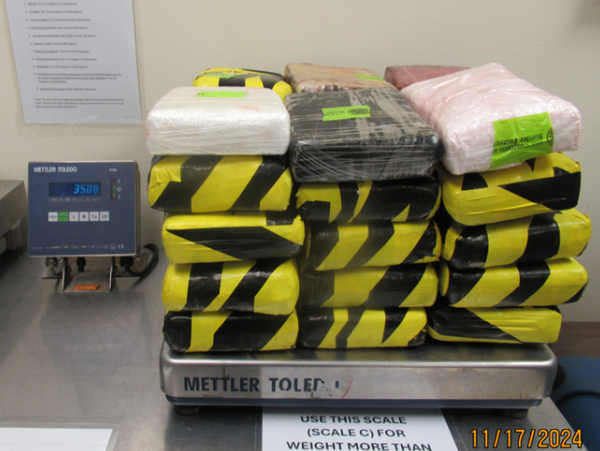
The US Coast Guard says it is doing all it can to locate a submersible vessel that went missing off the eastern coast of Canada and the United States during an expedition to visit the wreckage of the Titanic.
The British Broadcasting Corporation (BBC) first reported on Monday morning that a search and rescue operation was launched off the coast of Canada’s Newfoundland.
Rear Admiral John Mauger, commander of the First US Coast Guard District in Boston who is leading the search effort, said on Monday afternoon that officials were notified a day earlier that the vessel, which had five people onboard, was overdue.
“The location of the search is approximately 900 miles [1,450km] east of Cape Cod in a water depth of roughly 13,000 feet [3,900 metres]. It is a remote area and it is a challenge to conduct a search [there],” Mauger told reporters during a news conference.
He said the Canadian Coast Guard and the Canadian Armed Forces were also involved in the operation. Search and rescue vessels and aircraft, as well as sonar buoys, are being used, among other tools, Mauger added.
“Our first thoughts are with the crew members and the families of those onboard, and so we want to make sure that we have done absolutely everything that we can do to locate their family members and bring them home safe,” he said.
OceanGate Expeditions, a company based in the US state of Washington that deploys crewed submersibles for deep-sea expeditions, told media outlets in a statement earlier on Monday that its vessel was the subject of the rescue operation.
“Our entire focus is on the crewmembers in the submersible and their families,” the company said.
The wreck of the Titanic lies about 400 miles off the coast of Newfoundland. Without any cell towers in the middle of the ocean, we are relying on @Starlink to provide the communications we require throughout this year’s 2023 Titanic Expedition.
More: https://t.co/F7OtKI0En7 pic.twitter.com/wr7HeKlGjj
— OceanGate Expeditions (@OceanGateExped) June 14, 2023
OceanGate did not say how many people were on board the missing vessel but said it was “deeply thankful for the extensive assistance we have received from several government agencies and deep sea companies in our efforts to reestablish contact with the submersible”.
David Concannon, an adviser to the company, said OceanGate lost contact with the sub on Sunday morning. It had a 96-hour oxygen supply, he said in an email to The Associated Press news agency on Monday afternoon.
“Now 32 hours since sub left surface,” said Concannon, adding that officials are working to get a remotely operated vehicle that can reach a depth of 6,000 metres (about 20,000 ft) to the site as soon as possible.
Meanwhile, Action Aviation confirmed that its company chairman, British businessman Hamish Harding, was one of the tourists onboard. The company’s managing director, Mark Butler, told AP that the crew set out on Friday.
“Every attempt is being made for a rescue mission. There is still plenty of time to facilitate a rescue mission; there is equipment on board for survival in this event,” Butler said. “We’re all hoping and praying he comes back safe and sound.”
In an Instagram post on Saturday, Harding said he was “proud to finally announce” that he would take part in the expedition.
“Due to the worst winter in Newfoundland in 40 years, this mission is likely to be the first and only manned mission to the Titanic in 2023. A weather window has just opened up and we are going to attempt a dive tomorrow,” he wrote.
Harding’s post indicates another crew member who might be aboard the missing submarine: Paul Henry Nargeolet, a French researcher who has previously done work on the Titanic. “The team on the sub has a couple of legendary explorers, some of which have done over 30 dives to the RMS Titanic since the 1980s, including PH Nargeolet,” Harding wrote.

Five-person crew
The 2023 expedition was OceanGate’s third annual mission to visit the shipwreck of the Titanic, which sank on April 15, 1912, after colliding with an iceberg on its maiden voyage from Southampton, England, to New York City.
The wreck of the ill-fated ocean liner has been explored extensively since it was first discovered in 1985 about 650km (404 miles) off the east coast of Canada.
OceanGate last tweeted about this year’s expedition on Friday, saying it had been “an incredibly busy two weeks”.
A few days earlier, on Wednesday of last week, it also said on Twitter that its crew was relying on the Starlink satellite network to provide communications in the middle of the Atlantic Ocean.
“After the successful expeditions to the wreck in 2021 and 2022, OceanGate Expeditions will continue to return annually to further document the Titanic and its rate of decay,” the company says on its website.
The @USCG is searching for a 21-foot submersible from the Canadian research vessel Polar Prince.
The 5 person crew submerged Sunday morning, and the crew of the Polar Prince lost contact with them approximately 1 hour and 45 minutes into the vessel’s dive.
— USCGNortheast (@USCGNortheast) June 19, 2023
The OceanGate expedition, which costs $250,000 per person, starts in St John’s, Newfoundland, before heading out to the wreckage site, according to the company’s website.
To visit the wreck, passengers climb inside Titan, a five-person submersible, which takes about two hours to descend to the Titanic.
In a tweet on Monday afternoon, the US Coast Guard said it was searching for a 6-metre (21-foot) submersible that had launched from a Canadian research vessel known as Polar Prince.
“The 5 person crew submerged Sunday morning, and the crew of the Polar Prince lost contact with them approximately 1 hour and 45 minutes into the vessel’s dive,” it said.
‘Very difficult’
Chris Parry, a retired navy rear admiral from the United Kingdom, told Sky News that ocean conditions around where the Titanic shipwreck lies will make the ongoing search “a very difficult operation”.
“The actual nature of the seabed is very undulating. Titanic herself lies in a trench. There’s lots of debris around. So trying to differentiate with sonar in particular and trying to target the area you want to search in with another submersible is going to be very difficult indeed,” Parry said.
Al Jazeera’s Gabriel Elizondo, reporting from New York on Monday afternoon, said the search is taking place in an “incredibly remote” part of the northern Atlantic Ocean.
“There is no word at all of any sort of condition on the submarine, or the people on board, because all communication has been lost with it,” Elizondo said.
“We do know that this submarine is small by submarine standards; it’s about the size of a big truck. It carries a maximum of five people [and] that includes the crew.”







